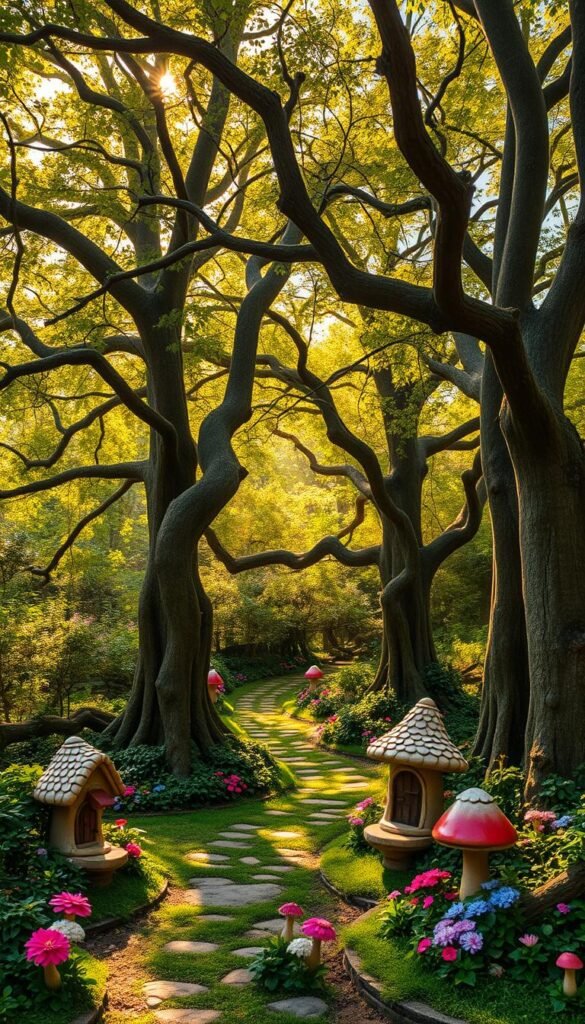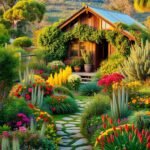What if your backyard could become a world where creativity blooms alongside flowers? Enchanted miniature landscapes offer kids a unique blend of play and learning, blending nature with storytelling. These tiny worlds turn ordinary outdoor areas into vibrant playgrounds where young minds design, plant, and dream.
Your little ones gain hands-on experience with plants while arranging pebble paths or choosing flowers for their whimsical setups. They’ll learn responsibility by watering succulents and troubleshooting sunlight needs—skills that grow as steadily as their garden.
Best of all, these projects fit any space. A patio planter or corner of a sandbox can host a thriving ecosystem. Families bond over shared tasks like crafting tiny furniture or naming mossy “forest” creatures. The result? Memories that outlast seasons and lessons that stick like burrs on socks.
Inspiring Ideas for an Enchanting Outdoor Fairytale
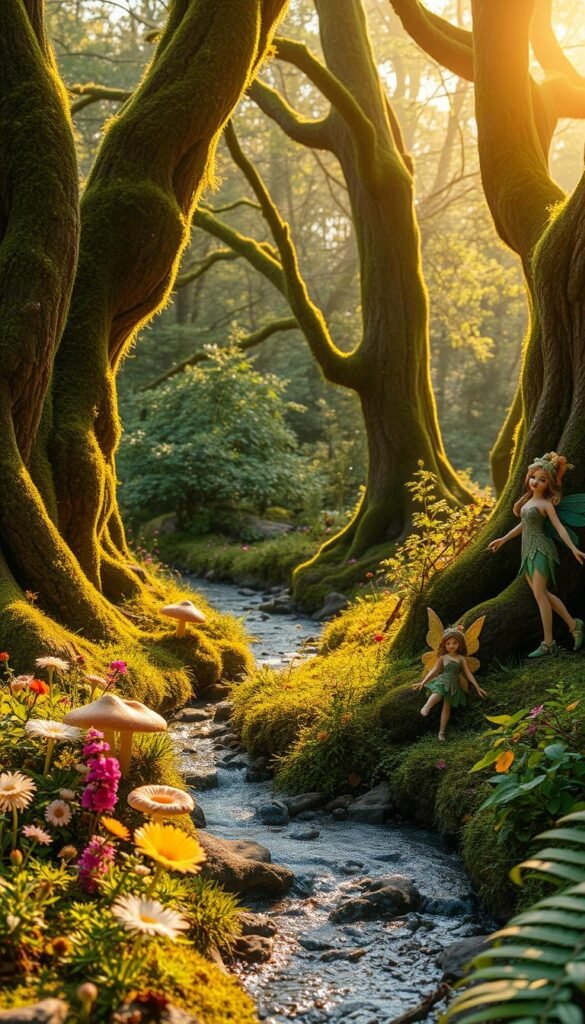
Ever notice how a simple stick becomes a wizard’s wand in little hands? That same magic transforms ordinary spaces into wonderlands when you build tiny realms together. Start by observing what makes your child’s eyes light up—maybe their tooth fairy ritual or favorite storybook characters.
Dreaming Up Your Unique Theme
Does your explorer collect pinecones or build sandcastles? Match their quirks with themes like beachside cottages using seashells or mossy treehouse villages. One family turned their sloped yard into tiered neighborhoods where pebble staircases connect miniature homes. “It’s like our own Shire,” their 7-year-old declared while arranging acorn caps as fairy bowls.
Creative Layout Inspirations
Twig bridges over cracked soil become epic troll crossings. Use old baking trays as modular planters kids can rearrange weekly. Try these layout tricks:
- Looping gravel trails that pass “hidden” treasures
- Stacked stones creating elevation changes
- Broken pottery pieces as whimsical seating areas
A tutorial from the Brooklyn Botanic Garden shows how fallen leaves make perfect fairy hammocks. Rotate elements seasonally—pumpkin seats in autumn, ice crystal ornaments in winter. Your space evolves alongside your child’s imagination.
Planning Your Magical Fairy Garden with Children
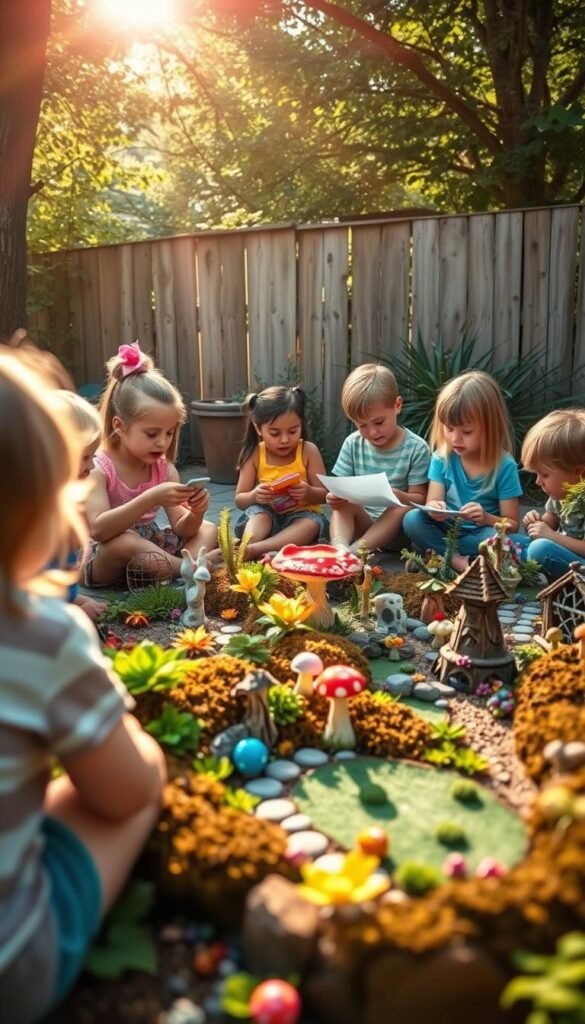
Imagine a project where every decision sparks joy and learning for your little ones. Planning these miniature worlds turns ordinary afternoons into adventures in teamwork and problem-solving. Start by asking questions like, “Where should our gnome friends live?” or “Which plants will thrive here?”
Choosing the Ideal Location and Container
Let your kids lead the hunt for the perfect spot. They’ll learn to assess sunlight patterns and drainage while scouting areas safe from curious pets. One family chose an old wheelbarrow as their planter—portable enough to chase sunshine yet sturdy for weekly redesigns.
Collaborative Design: Involving Your Kids
Structured worksheets turn whimsy into actionable steps. Kids love checking off tasks like measuring soil depth or sketching paths for tiny visitors. One 9-year-old designer insisted, “Our fairy post office needs a roof made of maple seeds!”
| Factor | Kid-Friendly Tip | Skill Developed |
|---|---|---|
| Sunlight Exposure | Use chalk to track shadows | Scientific observation |
| Container Size | Compare hand spans to pot diameters | Spatial reasoning |
| Visitor Access | Role-play as fairies entering the space | Empathy & design thinking |
Making fairy habitats teaches compromise too. When space is limited, creative solutions emerge—like vertical planters using recycled soda bottles. These choices build confidence as young gardeners see their ideas take root.
Fairy Garden Designs for Children’s Play Spaces
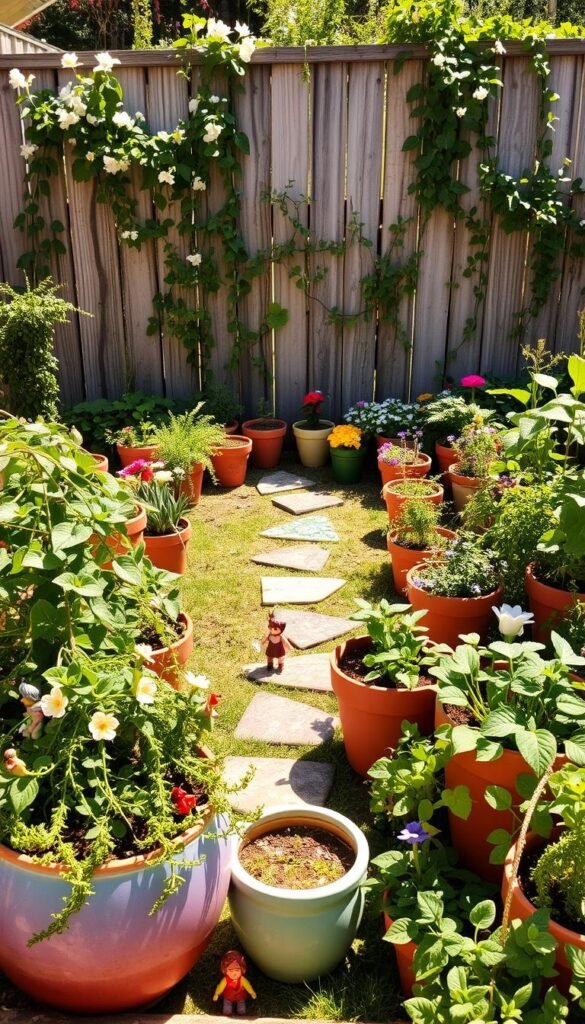
Where do stories grow best? In spaces where sunlight dances with shadows and tiny worlds fit small hands. Let’s explore how to match your family’s creativity with practical setups that thrive.
Selecting the Right Spot for Maximum Whimsy
Watch where afternoon light pools in your yard—that’s prime real estate for miniature ecosystems. A north-facing patio might host shade-loving moss castles, while sunny windowsills become deserts for succulents. One parent shared, “Our old boots became fairy garden play ideas near the raspberry bushes—the perfect hideout!”
Repurposed containers add character. Try colanders for drainage or bookshelves turned vertical villages. Balance accessibility with enchantment: low walls let kids tend plants without trampling delicate scenes.
Deciding on Scale and Functionality
Start small but dream big. A single planter teaches care routines, while connected areas encourage storytelling across “lands.” Consider:
- Plant heights that match miniature furniture
- Path widths for tiny toy visitors
- Growth space for expanding narratives
Rotate colorful container gardening elements seasonally—dwarf marigolds in summer, pansies in spring. This keeps the area fresh while teaching plant life cycles. Remember, the best designs grow alongside your child’s imagination.
Essential Garden Elements: Plants, Soil, and Accessories
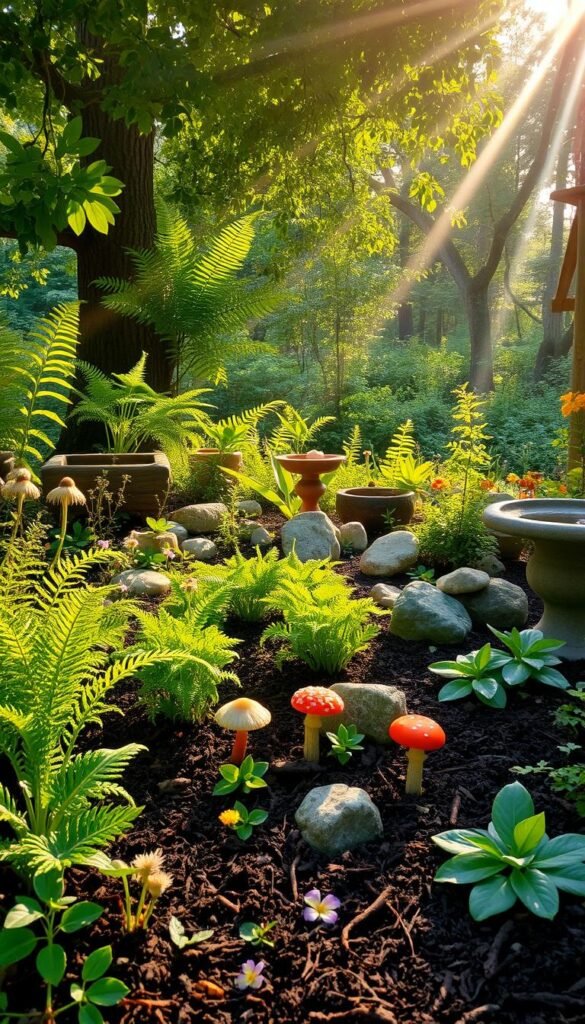
Ever wonder what makes a tiny ecosystem thrive? The secret lies in pairing the right green friends with nutrient-packed foundations. Let’s dig into the building blocks that turn containers into vibrant living scenes.
Plant Science for Little Gardeners
Shade-loving varieties like dwarf hydrangea become fairy “trees,” while Creeping Jenny spills over edges like emerald waterfalls. Blue lobelia flowers mimic miniature ponds, and fittonia’s pink veins look like magic runes. Kids learn biology by tracking each plant’s needs:
- Scientific names (Lysimachia nummularia ‘Aurea’ sounds like a spell!)
- Water schedules marked on painted rocks
- Growth charts comparing saxifraga sprouts to toy figurines
Using Soil and Compost for a Lush Base
Mix dark potting soil with compost to create a fluffy, moisture-rich bed. One parent shared, “Our homemade ‘dirt cake’ recipe—two parts soil, one part compost—keeps plants happy all summer.” Teach kids to test drainage by squeezing handfuls: proper blends hold shape then crumble when poked.
| Plant | Height | Special Power |
|---|---|---|
| Dwarf Hydrangea | 6-8″ | Creates shade for moss |
| Creeping Jenny | 2-4″ | Spreads like fairy carpet |
| Fittonia | 4-6″ | Teaches vein patterns |
Add small plants strategically—taller ones in back, cascaders up front. Rotate pots weekly so each side gets sunlight. Soon, your crew will spot new roots poking through the soil, proof their care makes magic grow.
DIY Crafts and Upcycled Decor Ideas for a Fairy Garden
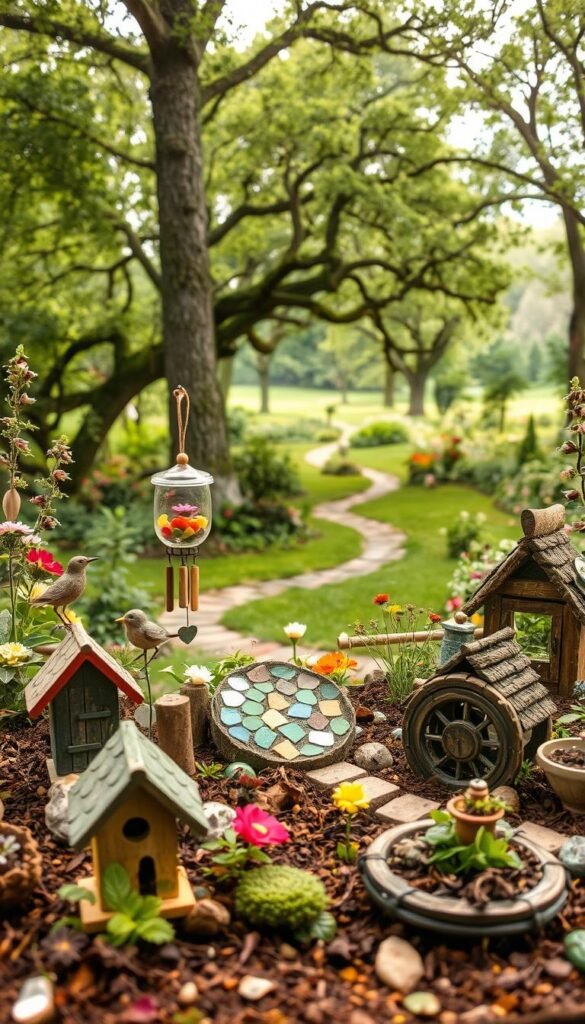
Who knew your recycling bin held the keys to a magical kingdom? Transform forgotten items into enchanting landscapes using everyday objects. Metal containers become shimmering towers, plastic lids morph into lily pad ponds, and old books bloom as secret planters. This hands-on approach sparks creativity while teaching sustainability through play.
Repurposing Household Items for Unique Planters
Let kids raid the kitchen for supplies. A dented colander makes an ideal hanging planter—its holes provide natural drainage. “Our pasta strainer became a floating cloud village,” shares one parent. Try these swaps:
- Metal tins: Paint weathered cookie containers as rustic cottages
- Plastic lids: Glue pebbles around edges to create miniature wells
- Wooden crates: Stack them into tiered herb gardens
Follow DIY garden art projects to turn broken teacups into bubbling fountains or fashion bridges from popsicle sticks. Twigs become arched entryways when secured with waterproof glue, while moss-covered rocks hide “crystal” marbles as treasure.
Nature walks double as material hunts. Collect acorn caps for fairy bowls, flat stones for stepping paths, and pinecones that transform into evergreen trees when painted green. Store finds in labeled jars for rainy-day crafting sessions.
| Material | Upcycled Use | Skill Practiced |
|---|---|---|
| Metal container | Planter base | Painting & sealing |
| Plastic bottle | Hanging greenhouse | Cutting & measuring |
| Old book | Hidden succulent bed | Precision gluing |
These projects adapt to any theme. Want a beach vibe? Fill glass jars with sand and tiny seashells. Prefer a woodland retreat? Bark shingles and lichen-covered sticks create cozy cabins. The only limit? Your family’s imagination.
Bringing Your Magical Space to Life: Next Steps and Final Tips
Ready to turn imagination into reality? Start by setting weekly maintenance dates with your crew. Kids thrive on routine—watering days become adventures when paired with “fairy inspections” for wilted leaves or new sprouts. Use old toys as quirky decorations: a toy truck becomes a gnome delivery vehicle, while plastic dinosaurs guard mossy mountains.
Rotate accessories seasonally to keep the area fresh. Swap summer seashells for autumn pinecones, or add twinkle lights during winter months. Pro tip: Take photos monthly to track growth and spark design upgrades. One family turned these snapshots into a growth chart showing both plants and their child’s creativity.
Encourage storytelling through small changes. Move figurines nightly to create mystery—”Did the fairies have a moonlit picnic?” Share progress in online parenting groups or local clubs. These connections often reveal clever hacks, like using coffee filters as umbrellas or chalkboard paint for changeable signs.
Finally, embrace imperfections. Crooked pebble paths and lopsided stick houses add charm. Your space evolves as skills grow, proving that magic isn’t about perfection—it’s about the joy of building something together.

